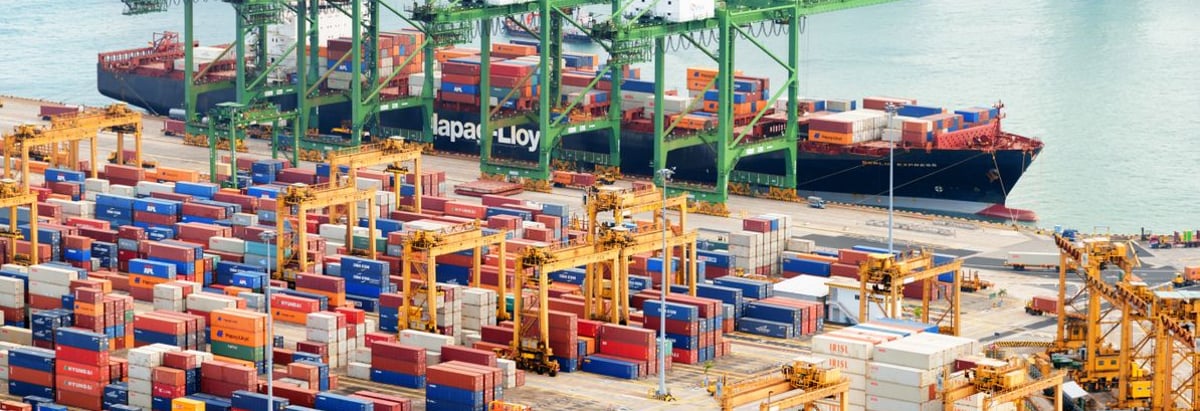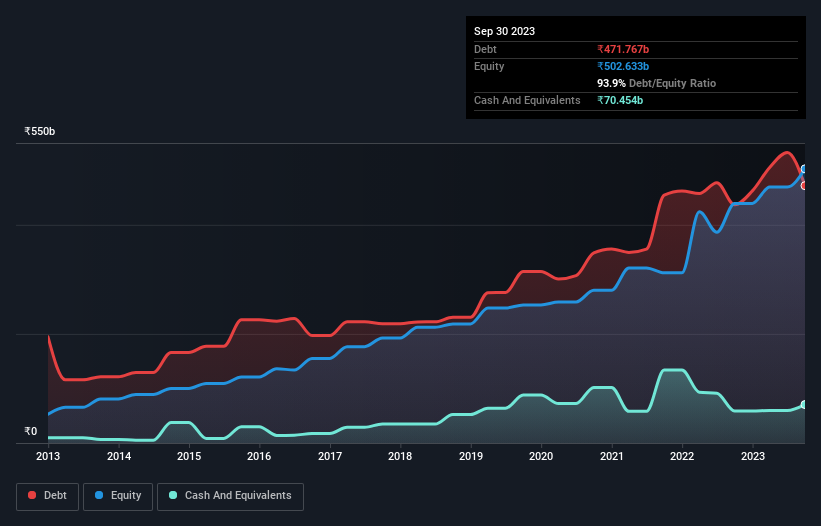- India
- /
- Infrastructure
- /
- NSEI:ADANIPORTS
Here's Why Adani Ports and Special Economic Zone (NSE:ADANIPORTS) Can Manage Its Debt Responsibly

Some say volatility, rather than debt, is the best way to think about risk as an investor, but Warren Buffett famously said that 'Volatility is far from synonymous with risk.' It's only natural to consider a company's balance sheet when you examine how risky it is, since debt is often involved when a business collapses. We can see that Adani Ports and Special Economic Zone Limited (NSE:ADANIPORTS) does use debt in its business. But should shareholders be worried about its use of debt?
When Is Debt Dangerous?
Generally speaking, debt only becomes a real problem when a company can't easily pay it off, either by raising capital or with its own cash flow. In the worst case scenario, a company can go bankrupt if it cannot pay its creditors. However, a more usual (but still expensive) situation is where a company must dilute shareholders at a cheap share price simply to get debt under control. By replacing dilution, though, debt can be an extremely good tool for businesses that need capital to invest in growth at high rates of return. When we examine debt levels, we first consider both cash and debt levels, together.
Check out our latest analysis for Adani Ports and Special Economic Zone
What Is Adani Ports and Special Economic Zone's Debt?
As you can see below, at the end of September 2023, Adani Ports and Special Economic Zone had ₹471.8b of debt, up from ₹436.7b a year ago. Click the image for more detail. On the flip side, it has ₹70.5b in cash leading to net debt of about ₹401.3b.

How Healthy Is Adani Ports and Special Economic Zone's Balance Sheet?
According to the last reported balance sheet, Adani Ports and Special Economic Zone had liabilities of ₹125.3b due within 12 months, and liabilities of ₹513.3b due beyond 12 months. Offsetting these obligations, it had cash of ₹70.5b as well as receivables valued at ₹34.9b due within 12 months. So its liabilities total ₹533.2b more than the combination of its cash and short-term receivables.
Adani Ports and Special Economic Zone has a very large market capitalization of ₹1.75t, so it could very likely raise cash to ameliorate its balance sheet, if the need arose. However, it is still worthwhile taking a close look at its ability to pay off debt.
In order to size up a company's debt relative to its earnings, we calculate its net debt divided by its earnings before interest, tax, depreciation, and amortization (EBITDA) and its earnings before interest and tax (EBIT) divided by its interest expense (its interest cover). The advantage of this approach is that we take into account both the absolute quantum of debt (with net debt to EBITDA) and the actual interest expenses associated with that debt (with its interest cover ratio).
With net debt to EBITDA of 2.9 Adani Ports and Special Economic Zone has a fairly noticeable amount of debt. On the plus side, its EBIT was 7.2 times its interest expense, and its net debt to EBITDA, was quite high, at 2.9. Also relevant is that Adani Ports and Special Economic Zone has grown its EBIT by a very respectable 24% in the last year, thus enhancing its ability to pay down debt. When analysing debt levels, the balance sheet is the obvious place to start. But ultimately the future profitability of the business will decide if Adani Ports and Special Economic Zone can strengthen its balance sheet over time. So if you're focused on the future you can check out this free report showing analyst profit forecasts.
Finally, a company can only pay off debt with cold hard cash, not accounting profits. So the logical step is to look at the proportion of that EBIT that is matched by actual free cash flow. Over the most recent three years, Adani Ports and Special Economic Zone recorded free cash flow worth 57% of its EBIT, which is around normal, given free cash flow excludes interest and tax. This free cash flow puts the company in a good position to pay down debt, when appropriate.
Our View
Adani Ports and Special Economic Zone's EBIT growth rate suggests it can handle its debt as easily as Cristiano Ronaldo could score a goal against an under 14's goalkeeper. But truth be told we feel its net debt to EBITDA does undermine this impression a bit. We would also note that Infrastructure industry companies like Adani Ports and Special Economic Zone commonly do use debt without problems. Looking at all the aforementioned factors together, it strikes us that Adani Ports and Special Economic Zone can handle its debt fairly comfortably. On the plus side, this leverage can boost shareholder returns, but the potential downside is more risk of loss, so it's worth monitoring the balance sheet. When analysing debt levels, the balance sheet is the obvious place to start. But ultimately, every company can contain risks that exist outside of the balance sheet. Be aware that Adani Ports and Special Economic Zone is showing 2 warning signs in our investment analysis , you should know about...
If you're interested in investing in businesses that can grow profits without the burden of debt, then check out this free list of growing businesses that have net cash on the balance sheet.
New: Manage All Your Stock Portfolios in One Place
We've created the ultimate portfolio companion for stock investors, and it's free.
• Connect an unlimited number of Portfolios and see your total in one currency
• Be alerted to new Warning Signs or Risks via email or mobile
• Track the Fair Value of your stocks
Have feedback on this article? Concerned about the content? Get in touch with us directly. Alternatively, email editorial-team (at) simplywallst.com.
This article by Simply Wall St is general in nature. We provide commentary based on historical data and analyst forecasts only using an unbiased methodology and our articles are not intended to be financial advice. It does not constitute a recommendation to buy or sell any stock, and does not take account of your objectives, or your financial situation. We aim to bring you long-term focused analysis driven by fundamental data. Note that our analysis may not factor in the latest price-sensitive company announcements or qualitative material. Simply Wall St has no position in any stocks mentioned.
About NSEI:ADANIPORTS
Adani Ports and Special Economic Zone
Operates and maintains port infrastructure facilities in India.
Solid track record with adequate balance sheet and pays a dividend.

